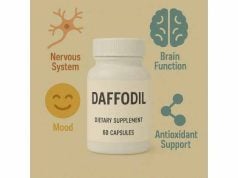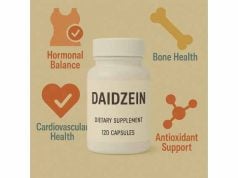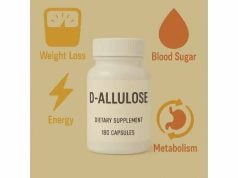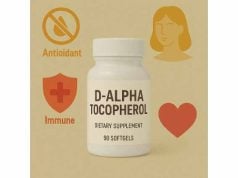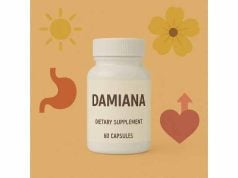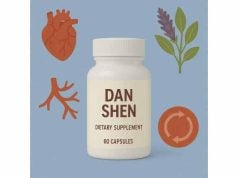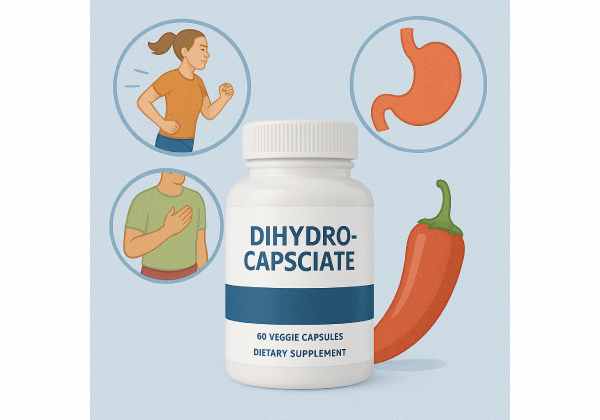
Dihydrocapsiate (DHC) is a non-pungent “capsinoid” found in a sweet chili pepper cultivar called CH-19. Unlike capsaicin, it does not burn the mouth, yet it still interacts with the same heat-sensing receptor (TRPV1) that influences thermogenesis. Early human trials suggest DHC can nudge energy expenditure upward and may support fat oxidation, while newer studies clarify where its effects are modest, conditional, or absent. This guide explains how DHC works, what outcomes to expect, who might benefit, how to dose it intelligently, and where the safety limits lie. You will also see how DHC compares with capsaicin and capsiate, plus a concise read of the research record—so you can decide if this supplement fits your goals, budget, and routine.
Quick Dihydrocapsiate Highlights
- May slightly increase energy expenditure and support diet-induced thermogenesis.
- Human results are mixed; benefits appear small without diet and activity changes.
- Typical studied intake: 3–9 mg/day; some trials used 12 mg before exercise.
- Avoid if pregnant or breastfeeding, with chili/pepper allergy, or active GI ulcers.
- Generally well tolerated and non-pungent; mild GI upset is possible.
Table of Contents
- What is dihydrocapsiate?
- Does dihydrocapsiate help with weight loss?
- How to take dihydrocapsiate day to day
- Dihydrocapsiate vs capsaicin and capsiate
- Side effects and who should avoid it
- Evidence snapshot and research gaps
What is dihydrocapsiate?
Dihydrocapsiate (DHC) belongs to a family of chili-derived compounds called capsinoids. These include capsiate, dihydrocapsiate, and nordihydrocapsiate—structurally similar to capsaicin but lacking the pungent “sting.” DHC was first characterized in CH-19 Sweet, a non-pungent pepper bred in Japan. It interacts with transient receptor potential vanilloid-1 (TRPV1), the same ion channel capsaicin activates in sensory nerves and the gut. Activation sends a “heat” signal that can increase sympathetic outflow and slightly elevate energy expenditure (thermogenesis). Because DHC is non-pungent, it offers a way to engage this pathway without mouth or gastric burning.
Mechanistically, DHC appears to act primarily in the gastrointestinal tract rather than the oral cavity. After ingestion, it can stimulate gut-to-brain signaling that influences metabolism and, in some contexts, brown adipose tissue (BAT) activity—tissue specialized for heat production. Human studies have assessed whether regular ingestion changes resting metabolic rate, diet-induced thermogenesis after meals, substrate use (fat versus carbohydrate oxidation), and, more recently, BAT-related measures (e.g., vascular density proxies).
A crucial nuance: “thermogenic” does not mean “dramatic weight loss.” Most well-controlled trials report small changes in energy expenditure—on the order of a few dozen kilocalories per day—with variability across people. That magnitude is similar to normal day-to-day metabolic fluctuations, which is why real-world results depend on context. DHC is better viewed as a nudge that may complement a calorie-aware diet and regular activity rather than a stand-alone fat-loss agent.
From a user-experience standpoint, DHC is typically encapsulated, tasteless at common doses, and does not cause the typical capsaicin “flush.” Formulas may provide DHC alone or a standardized capsinoid blend. Labels sometimes emphasize “non-pungent chili extract,” which is accurate for dihydrocapsiate but doesn’t guarantee effectiveness by itself; dose, timing, and the rest of your routine still matter.
Finally, because DHC targets a physiological heat-sensing pathway, you might notice subtle shifts in warmth or post-meal heat production, especially when taken with protein-rich meals. However, many users feel nothing obvious—and that’s normal. The intended effect is small and internal rather than a stimulant buzz or pronounced heat sensation.
Does dihydrocapsiate help with weight loss?
Short answer: DHC can modestly increase energy expenditure and post-meal thermogenesis in some settings, but it’s not a stand-alone weight-loss solution. Longer answer: Evidence spans early randomized trials of 3–9 mg/day over several weeks, controlled feeding studies, and newer trials using 9–12 mg in specific populations. The most consistent pattern is a small uptick in thermogenesis with little or no change in resting metabolic rate when averaged across groups. Some post-meal effects appear more detectable when background diets are high in protein or during structured, calorie-restricted programs.
Why does that matter? Diet-induced thermogenesis can decline with weight loss, dampening momentum. A supplement that blunts that decline or adds back a small thermic boost could, in theory, help you maintain a calorie deficit more comfortably. In practice, the magnitude is small—think roughly dozens of kilocalories, not hundreds—so it won’t bridge an otherwise unchanged lifestyle. The most favorable outcomes tend to appear when DHC is layered onto a plan that already includes protein-forward meals, fiber, and daily movement.
What about fat oxidation and brown fat? Some studies suggest DHC or mixed capsinoids can encourage fat use under specific conditions or increase proxies for brown adipose tissue activity; others find no meaningful difference. Newer, highly controlled exercise studies—using 12 mg acutely before aerobic or resistance sessions—report no improvement in energy expenditure during exercise, fat oxidation during steady-state cycling, or strength and power outcomes. That suggests DHC is not an ergogenic aid and that any thermogenic benefit may be limited to resting or post-meal contexts rather than performance settings.
Who seems to benefit most? Individuals with overweight who are actively dieting and eating adequate protein may be more likely to see small thermic effects. People expecting a visible change on the scale from DHC alone will be disappointed. This supplement is best thought of as a gentle adjunct for metabolic “tidying,” not a trigger for substantial fat loss.
Bottom line: The totality of evidence supports at most a modest thermogenic effect that is unlikely to produce meaningful weight loss by itself. If you already prioritize nutrition quality, daily steps, and resistance training, DHC may provide a small additional nudge—useful for some, negligible for others.
How to take dihydrocapsiate day to day
Forms and labels. Most products supply purified dihydrocapsiate or a standardized capsinoid complex in capsules. Because capsinoids are heat-sensitive, reputable brands encapsulate them to protect stability. Typical units are milligrams of “dihydrocapsiate” or “capsinoids (as dihydrocapsiate).”
Dosage used in research. Common study ranges are 3–9 mg/day, usually split across meals for 4–6 weeks. A few trials assessed 12 mg as a single acute dose before exercise; those did not improve energy use during workouts or strength performance. If you’re new to DHC, a practical approach is:
- Start at 3 mg/day with breakfast for 1 week to assess tolerance.
- Increase to 6 mg/day (e.g., 3 mg with breakfast and dinner) if no issues after a week.
- Consider 9 mg/day divided across two or three meals if you’re pursuing a structured, protein-forward weight-loss plan and tolerating it well.
Timing. Taking DHC with meals—especially protein-rich meals—aligns with the evidence on diet-induced thermogenesis. If you prefer once-daily dosing, breakfast is reasonable. There’s no strong evidence to favor pre-workout timing; newer trials show no performance benefit.
Stacking with lifestyle. DHC pairs logically with:
- High-protein meals (20–40 g/meal) to reinforce the thermic effect of food.
- Resistance training (2–4 sessions/week) for muscle retention during weight loss.
- Daily steps (7,000–10,000) to lift total daily energy expenditure.
- Sleep (7–9 hours) and circadian consistency, which influence appetite and activity.
Stacking with supplements. If you already use caffeine or green tea extract, understand that adding DHC won’t replace the need for diet and training. Combining many “thermogenics” increases cost and the chance of GI side effects without guaranteed additive benefits. Keep it simple: choose one or two evidence-based tools you tolerate.
How long to try it. Give DHC 4–6 weeks alongside a consistent routine before judging value. Track scale weight, waist measurements, step counts, and average daily protein. If nothing budges and your plan is otherwise on point, DHC likely isn’t moving the needle for you.
Practical cues it’s working. Subtle warmth after meals, slightly easier time maintaining a deficit, or stable energy during a cut. Absence of a “feeling” does not mean it’s ineffective, but any effect is small—your measurements matter more than sensation.
When to stop. If you develop persistent GI discomfort, heartburn, or no benefit after a fair trial, discontinue. As with any supplement, pause before surgeries and when starting new prescription medications, and review with your clinician if you have complex conditions.
Dihydrocapsiate vs capsaicin and capsiate
Origins and chemistry. All three—capsaicin, capsiate, and dihydrocapsiate—belong to a family of vanilloid compounds from peppers that interact with TRPV1. Capsaicin is the pungent molecule responsible for chili heat. Capsiate and dihydrocapsiate are capsinoids, an esterified subgroup that is non-pungent at typical doses. Among capsinoids, DHC is often favored in supplements because it’s better studied and stable in capsules.
Sensation and tolerability. Capsaicin can cause mouth burn, flushing, and GI irritation, particularly at higher intakes. DHC and capsiate generally avoid those issues because they don’t bind oral TRPV1 as strongly and are less irritating in the stomach. For people who dislike spicy foods or have reflux, DHC is the more comfortable choice.
Mechanisms. All three target TRPV1, but the where and how intensely differ. Capsaicin strongly activates TRPV1 on oral and gut nerves, producing a clear sensory effect. DHC tends to act more in the gut, producing physiological thermogenic signals with minimal sensation. Both may influence brown adipose tissue in specific contexts, but the evidence is mixed and effects are usually small.
Outcomes. Across studies, capsaicin and capsinoids can raise energy expenditure slightly; body-composition changes are inconsistent and generally minor unless combined with calorie control. For exercise performance, DHC has not shown ergogenic effects at 12 mg acutely. Capsaicin itself has some mixed data for endurance or pain perception at higher doses, but these can come with side effects and are not directly interchangeable with DHC.
Safety profile. DHC is typically well tolerated at studied doses (3–12 mg/day) with few adverse events reported in short-term trials. Capsaicin’s tolerability can be dose-limited by oral and GI burning. For long-term intake, safety data are more robust for dietary capsaicin (from foods) and adequate but still limited for chronic DHC supplementation; conservative use and periodic breaks are sensible.
Cost and practicality. DHC supplements can be more expensive per effective dose than simply eating spicy foods for those who tolerate capsaicin. If you enjoy chili peppers and have no GI issues, culinary approaches may be the most economical way to explore thermogenic effects. If you can’t tolerate pungency, DHC offers a gentler, standardized option.
Bottom line. Capsaicin, capsiate, and dihydrocapsiate all live in the same metabolic neighborhood, but DHC is the non-pungent choice with a modest and context-dependent effect profile, especially suited to people who want to avoid heat and GI discomfort.
Side effects and who should avoid it
Overall tolerability. DHC is considered well tolerated in short-term human studies at 3–12 mg/day. Because it’s non-pungent, most people don’t experience mouth burn or intense flushing. The most common complaints are mild GI symptoms (nausea, stomach discomfort, occasional heartburn), which usually resolve by lowering the dose or taking it with food.
Cardiometabolic effects. Unlike stimulant-based fat burners, DHC does not typically raise heart rate or blood pressure at studied doses. Still, if you have cardiovascular disease, arrhythmias, or uncontrolled hypertension, review any thermogenic supplement with your clinician and monitor blood pressure at home when you start.
Allergy and intolerance. Avoid DHC if you have a known allergy to chili peppers or capsicum-derived ingredients. If you have active gastritis, peptic ulcer disease, severe GERD, or a history of GI bleeding, DHC may aggravate symptoms and is best avoided.
Special populations.
- Pregnancy or breastfeeding: Avoid; there’s no adequate safety data.
- Children and adolescents: Not recommended due to insufficient evidence.
- Thyroid disorders and heat intolerance: Use caution. Thermogenic agents—even mild ones—may not be appropriate if you are sensitive to heat or have poorly controlled hyperthyroidism.
- Pre-operative periods: Stop at least 2 weeks before surgery unless your surgeon advises otherwise.
Drug and supplement interactions. Robust interaction data are limited. Because DHC’s effects are not stimulant-driven, interactions with heart medications are less likely than with caffeine-heavy formulas. Even so, avoid combining with multiple “thermogenic” products to reduce additive GI upset and cost. If you are on anticoagulants, antiarrhythmics, or medications with narrow therapeutic windows, check with your pharmacist.
Sourcing and quality. Choose brands that:
- Specify milligrams of dihydrocapsiate (or capsinoids as DHC) per serving.
- Provide lot numbers and third-party testing.
- Avoid proprietary blends that obscure the actual DHC dose.
When to seek care. Stop usage and consult a clinician if you experience severe or persistent abdominal pain, vomiting, black stools, chest discomfort, palpitations, or allergic reactions (rash, swelling, breathing difficulty).
Take-home. In healthy adults, short-term DHC use at modest doses is generally safe and non-pungent, but it isn’t risk-free. Use it thoughtfully, match dose to your goals, and prioritize fundamental habits that deliver most of the benefit.
Evidence snapshot and research gaps
What we know.
- Thermogenesis: Multiple randomized trials report small increases in energy expenditure with DHC or mixed capsinoids, especially around meals or during calorie restriction. Effects on resting metabolic rate are variable and usually small.
- Brown adipose tissue: Some human studies show changes in BAT-related metrics (e.g., vascular density proxies) with daily capsinoids; others find no significant impact on resting energy expenditure.
- Exercise performance: Two recent randomized, triple-blind crossover trials using 12 mg DHC acutely found no benefits for energy use during steady-state aerobic exercise or for neuromuscular performance in trained adults.
- Safety: Short-term dosing up to 12 mg/day appears well tolerated in healthy adults. Adverse events are typically mild and GI-related; significant hemodynamic effects are uncommon.
What remains uncertain.
- Long-term outcomes: We lack large, long-duration trials (>6 months) tracking weight maintenance, regain prevention, or metabolic health markers.
- Dose–response: Whether doses higher than 9 mg/day (chronic) meaningfully outperform 3–9 mg without side effects is unclear.
- Responder profiles: Individuals differ in BAT abundance, diet, and gut–brain signaling; we need better predictors of who benefits.
- Combination strategies: Interactions with dietary protein timing, cold exposure, or other non-stimulant thermogenics haven’t been fully tested.
Practical interpretation.
DHC fits the category of low-risk, low-reward adjuncts: it’s unlikely to harm and may help a bit, but the dominant drivers of body composition remain calorie intake, protein sufficiency, resistance training, and daily movement. If you’re already doing these well, DHC can be trialed for a few weeks to see if it nudges progress. If your fundamentals aren’t in place, DHC won’t compensate.
How to assess value personally.
- Track a 4–6 week period with stable habits and either 0 mg (baseline) or a set DHC dose.
- Log protein, steps, training, and sleep to minimize confounders.
- Use the average of multiple weigh-ins, waist measurements, and, if possible, a simple food log.
- If the addition of DHC corresponds with better adherence or a modest trend in the desired direction—and you tolerate it—it may be worth keeping. If not, redirect the budget toward high-impact basics (protein-rich foods, coaching, gym membership).
References
- Effect of dihydrocapsiate on resting metabolic rate in humans (2010) (RCT)
- Effects of dihydrocapsiate on adaptive and diet-induced thermogenesis with a high protein very low calorie diet: a randomized control trial (2010) (RCT)
- Effects of Capsinoid Intake on Brown Adipose Tissue Vascular Density and Resting Energy Expenditure in Healthy, Middle-Aged Adults: A Randomized, Double-Blind, Placebo-Controlled Study (2020) (RCT)
- Dihydrocapsiate does not increase energy expenditure nor fat oxidation during aerobic exercise in men with overweight/obesity: a randomized, triple-blinded, placebo-controlled, crossover trial (2022) (RCT)
- Capsaicin for Weight Control: “Exercise in a Pill” (or Just Another Fad)? (2022) (Review)
Medical Disclaimer
The information in this article is educational and general in nature. It is not a substitute for personalized medical advice, diagnosis, or treatment. Always consult a qualified healthcare professional before starting, stopping, or combining supplements, especially if you are pregnant or breastfeeding, have medical conditions, or take prescription medications.
If you found this helpful, feel free to share it on Facebook, X (formerly Twitter), or your favorite platform, and consider following us for future evidence-based guides. Your support helps us keep creating high-quality resources.

